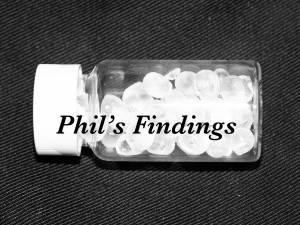Phil’s Findings #16: Glass
03 October 2011


Phil Howes, the Institute of Making’s post-doc researcher, shares his thoughts and findings as he delves into the world of materials. Check this space every second Monday for Phil's latest posting.
Glass is an incredible material which finds a use in almost all parts of our life. The word itself is embedded in our material language – ask for ‘a glass’ and you’re asking for a something to drink from, or when talking about ‘glasses’ we are referring to spectacles. It is a very versatile material, being used in everything from fine jewellery and to colossal sky scrapers, and everything in between. Soda lime glass is the most common variety, and is used in almost all standard applications, from photo frames to window panes. Over the hundreds of years since glass production began, many formulations have been developed as the usage of glass has diversified. For example, early motor cars used to have soda lime glass windscreens, but the tendency of the glass to shatter into lethal shards in a crash made it a necessity for car manufacturers to find a better solution (not least because injured car drivers began enthusiastically suing them). The solution of the day was to replace the standard glass with hardened glass which, upon breaking, shattered into many small and relatively harmless pieces. This is done by applying a special heat and chemical treatments during glass production which induces internal tension to the glass, and surface compression. The surface compression acts to strengthen the glass surface, but also causes the glass to shatter into many small pieces if it is broken.
Glass has been used by man since the Stone Age. Shards of naturally occurring glasses where used for cutting, and it became somewhat of a precious commodity due to its scarcity. It is currently thought that the first man-made glass was made in the Old Kingdom of Egypt, in the north of what is now Syria, in the third century BCE. These were glass beads thought to be a by-product of metal-working. From there, there was a rapid spread in glass making a rapid progress made in glass making technologies. Methods of working, shaping and colouring were developed over many centuries, and the many variations and uses of glass have made a big impact on almost all civilisations and societies right up into the present day.
The most significant physical property is its amorphous structure. Upon solidification, many substances undergo a process of crystallisation where the atoms arrange themselves in a regular structure. For example table salt – which is composed of sodium chloride – is made of salt crystals with an alternating arrangement of sodium and chlorine atoms which repeats throughout the structure. Glasses, on the other hand, do not have this regular arrangement of atoms, meaning there is no repeating unit of structure throughout the solid. Traditional glasses contain a large amount of silica, a mixture of silicon and oxygen, of which sand (or more specifically quartz) is a major source. Soda lime glass, for example, is three quarters silica, with potassium oxide (the ‘soda’) and calcium oxide (the ‘lime’) making up the rest. Each silicon atom is linked to three oxygen atoms, and although this atomic arrangement is repeated throughout, there is no overall repeating pattern.